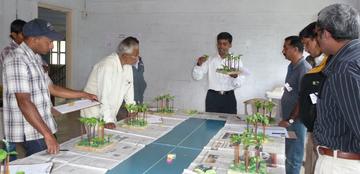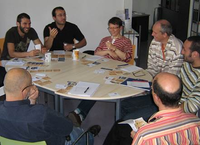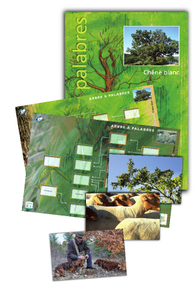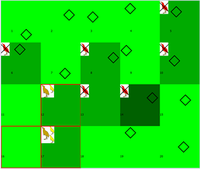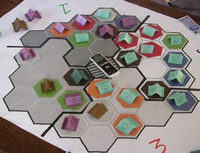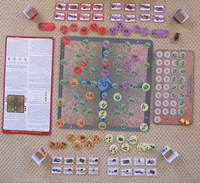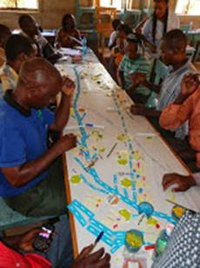Program
Resilience Plaza
Last update: 6 May 2014
Table top games and role play for the general public to raise awareness of how to take account of uncertainty, adaptation and co-management of crises and unexpected changes.
Resilience Plaza
An opportunity to experience games related to natural resources management
with the general public
Date
Wednesday May 7, 13:00 – 15:30
Venue
If the weather is nice, the Resilience Plaza event will be held outside, nearby the entrance of the Corum conference center, to invite the general public to join conference participants. In case of bad weather, it will be held in the “salon du Belvédère”.
Like all distributed simulation tools, games have the ability to rapidly generate complex interactions and dynamics between decision centers that can reflect – sometimes in a stylized way – the actual reality of some social-ecological systems. Usually, games constitute very specific settings, out of time and out of context, where players and games are supposed to be disconnected from current contingencies. Hence, after a session, participants have the opportunity to disqualify their behavioral patterns exhibited during the game: “It was just a game.” Still, games can temporarily create a space for “potential realities.” When the game stops, during the debriefing, the relation to the real world might be debated and collective learning might be explicitly acknowledged.
Resilience Plaza will offer you the possibility to test a few games that some of the participants in the conference have designed. With imperfect information, under time pressure, and with the outcome of your decision being strongly influenced by the decisions of the other players – will you be able to work your way through the common-pool resource dilemma you are going to face..?
Games presented @ Resilience Plaza
ARTISHOCK
Mathieu Dionnet - LISODE - Montpellier, France
ARTISHOCK is an educational role-playing game which deals with common-pool resource management. Game participants play two distinct roles: farmers who rely on groundwater to produce artichokes, and water managers who regulate groundwater use. Farmers have free access to groundwater, and are challenged to collectively manage this limited/renewable resource. During the game, the overexploitation of the resource leads the participants to collectively implement different strategies to respond to this situation. The objective of the game is to help participants to better understand the difficulties and challenges involved in participative common-pool resource management.
L’arbre à palabres
Michel Etienne – INRA, EcoDevelopment Unit – Avignon, France
L’arbre à palabres (”palaver tree”) has been developed for the 40 years of the UNESCO “Man and the Biosphere” Programme. This educational game for the general public focuses on the relationship between nature and society, through the representations of a tree from different perspectives (History, Literature, Science). Each French Biosphere Reserve has chosen one or more emblematic trees or vegetal species and declined the game board according to its own territory uses: Cevennes (chestnut), Corsica (holm oak), Fontainebleau (sessile oak), Provence-Lure (white oak), Ventoux (beech), Vosges du Nord (beech and apple), Guadeloupe (gum and pear), Camargue (reed). The game aims to reconstruct the interactions between human activities, animals and the different parts of a tree. The game board is made of a blank diagram to be correctly completed by 24 photos.
REHAB
Anne Dray, Claude Garcia,– ETH Zürich - Switzerland
Christophe Le Page - CIRAD, UPR Green – Montpellier, France
ReHab is a role-playing game aiming at fostering the importance of communication, through experiential learning, in the context of renewable resources management and conservation. The game consists in an abstract natural environment characterized by different levels of biomass of a given resource. Players control Harvesters to maximize long-term production and profit. Harvesting activities directly impact the local level of biomass and its regeneration but associated rules are not explained to the players. The environment is also a nesting and breeding area for an endangered migratory Bird. One (or more) player controls the role of Rangers whose task is to maximize the long-term rate of bird reproduction by establishing sanctuaries in the environment. The probability of successful reproduction is influenced by the harvesting activities, but the associated rules about disturbance levels are also kept hidden.
RESORTES
Erika Speelman - Farming Systems Ecology Group, Wageningen University - Wageningen, The Netherlands
The RESORTES (Redes Sociales y Ordenamiento Territorial Sustentable) board game is a stylized yet complex land-use game rich in ecological and social outcomes. The game was specifically developed for a usufruct community in the buffer zone of a Man and Biosphere Reserve in Chiapas, Mexico. It was part of a larger project on community territorial planning. The game focuses on the process of land-use coordination among smallholders and in particular on the preservation and use of forest in individual and communal lands within the territory. The game allows six players to select fields and their land-use types within a territory. Two simple rules trigger players to obtain benefits from coordinating their actions and to develop a joint landscape of forested and non-forested plots.
SIERRA SPRINGS
Luis García-Barrios -El Colegio de la Frontera Sur - Mexico
Sierra Springs (García-Barrios et al.) is a four-player board game -developed in the Sierra Madre de Chiapas, Mexico-that can be played under a number of different sets of rules, and that challenges participants to make a livelihood without collapsing critical ecological functions at the watershed level. It exposes participants to coordination, cooperation and solidarity dilemmas that emerge from their interaction under specified environmental limits, social norms and public policies.
It has been played by hundreds of farmers and academics who have enjoyed it and reflected collectively about its outcomes.
Wat-A-Game
Nils Ferrand & Géraldine Abrami (IRSTEA-Montpellier)
Wat-A-Game (WAG) is an open toolkit and a method based on simple bricks for designing and using role playing games for water management, policy design and education. The main principle of WAG is to use pebbles to show explicitly how water (and other resources) flows, and are transformed and used. WAG developers work together around a table with these simple bricks and pebbles using the “CREA-WAG” methodology and can get to a fairly advanced game prototype in a couple a days time
WAG is provided under a CC-by-nc-sa license. However, "all-in-one" WAG bags are available for sale. Regular training sessions are offered and our website www.watagame.info promotes a community spirit by offering space to WAG users to publish and share their experiences.
NomadSed
Romina Martin - Leibniz-Institute of Freshwater Ecology and Inland Fisheries - Berlin, Germany
In NomadSed, a board game on sustainable land use in drylands under global change, up to five players step into the role of a nomadic herdsman. The goal is to build the capital in terms of sheep. To do this, players need to decide on pasture movements to find enough forage. This decision not only depends on local pasture conditions but players need to consider events such as price changes and long term strategies. They deal with multiple challenges that occur in drylands: Eventually cooperation with neighbours becomes necessary or sheep have to be sold. Playing the board game can mediate insights into dynamic relationships of the environment and human livelihoods. This supports the dialogue on management decisions that are linked to real experiences by nomadic herdsmen.
Kazyeopoly
Tim Daw – Stockholm Resilience Center – Stockholm, Sweden
Kazyeopoly is a trap fishing game that was developed as an experiential learning and discussion tool to be played with Seychellois fishers during a fisheries co-management project. It has subsequently been used for University teaching of undergraduate and masters students at the University of East Anglia and Stockholm University, with school groups and the general public. Players act as fishers and make strategic decisions to position fisher traps and invest in fishing capital in an attempt to maximise their profits. The fish stock and stochasticity of catches are simulated by physical mechanisms. Over the course of the game typical dynamics of fisheries SES emerge as the players learn and respond to the dynamics of the resource.
Last update: 6 May 2014






